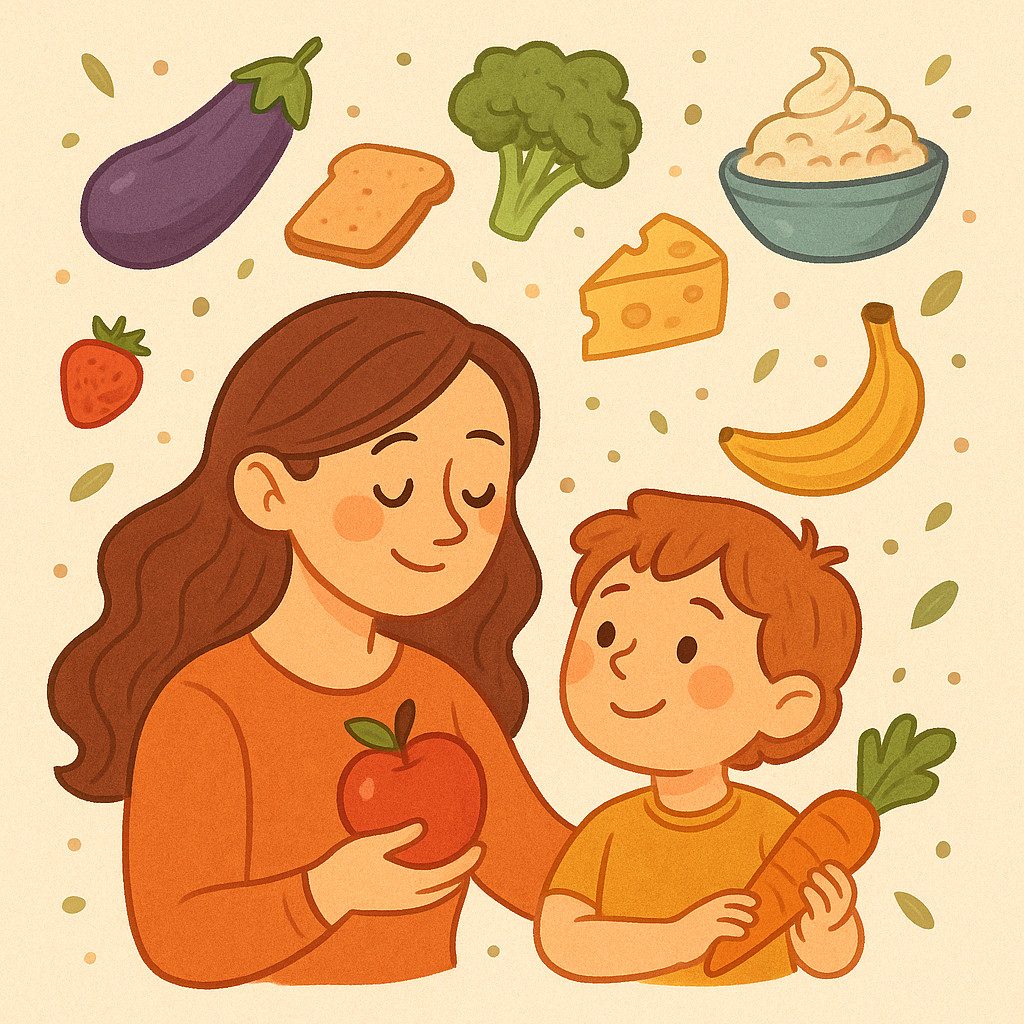In a world filled with diet culture, “clean eating” trends, keto diets, caveman diets, carnivores, vegetarians, vegans, gluten free, low-carb, low-fat, low-sodium. I’m low-patience. I want a simple way to eat and talk about healthy eating with our children. I don’t want food guilt disguised as wellness. I don’t want confusing labels that look healthy but aren’t. This is about creating a lifelong habit to enrich our little ones lifestyles. One of the most powerful gifts we can give our kids (and ourselves) is a healthy, shame-free relationship with food.

But how do we talk about nutrition?
How do we teach balance, and encourage healthy choices without labeling foods as “good” or “bad”?
How do we help our kids respect their bodies and eat with confidence, especially in a growing family where food habits often form around convenience, routines, and sometimes chaos?
It starts with how we talk. Our relationship with ourselves, our bodies, food and the perception and meaning of our actions and how our kids pick up on every little detail.
Talk the Talk, How We Talk About Food Matters
Kids are observant. Long before they can read a nutrition label, they notice how we act around dessert, what we say after eating pizza, or how we talk about needing to “burn off” a big meal. Desserts after dinner? Seconds, thirds (or fourths). And every action and intention around eating.
Think about it.
Think about how you handle each and every meal and what your kids could learn from that. Sunday Brunch, Snacks in the afternoon, pizza Fridays, pizza Mondays, pizza everyday?, are you eating vegetables?, fruit?, do you over-eat more often than not? do you know how and when to say no to yourself.
What language do you use around these events? what emotions are you conveying?
We need to learn how to treat our selves well before we can teach our kids, right?
These messages shape the inner voice they carry into adolescence and adulthood.
Even well-intentioned comments like:
- “You don’t need that second helping.”
- “That’s a lot of sugar—are you sure?”
- “Mom’s being good today—just a salad!”
…can create confusion and shame around food and appetite.
Instead, we can shift toward language that:
- Encourages curiosity about how food makes us feel
- Celebrates all foods as having a place
- Honors hunger and fullness without judgment
Here’s How to Shift the Conversation (Without the Diet Talk)
1. Focus on What Food Does, Not What It Is
Instead of saying “cookies are bad,” try:
“Cookies give us quick energy, but if we’re hungry for something that lasts, let’s add a cheese stick or apple too.”
This helps kids understand how different foods function without attaching moral value.
2. Use Neutral, Descriptive Language
Swap:
- ❌ “That’s junk food”
- ✅ “That’s a sometimes food—tastes sweet, but doesn’t fill our bellies for long.”
Avoid extremes like “superfoods” or “bad carbs.” All foods have something to offer, even if it’s just joy or tradition.
3. Avoid Commenting on Their Body (or Yours)
Steer clear of:
- “You’re getting chubby from too many snacks.”
- “I need to go on a diet after this weekend.”
Instead, say:
“Let’s check in with how our tummies feel—are we still hungry, or full?”
Let your kids see you enjoy food without shame. Your relationship with food will likely become their blueprint.
4. Let Them Lead the Way at Mealtimes
Encourage:
- Serving themselves
- Tuning into hunger/fullness
- Choosing what and how much to eat from what’s offered
This builds body trust and reduces power struggles.
Pro Tip: The Division of Responsibility model (by dietitian Ellyn Satter) suggests that parents decide what, when, and where kids eat, while children decide if and how much.
5. Create a Low-Stress Mealtime Environment
Avoid pressure, bribery, or food as reward (“Eat your veggies and you’ll get dessert”). This can turn food into a power game instead of a nourishing connection.
This is a hard one for us, our kids love their sweet treats and sometimes that is the reward after the doctors office or cleaning up.
No one said this was going to be easy, but what’s right for your kids isn’t always easy.
Make meals about togetherness, not performance.
What About Nutrition?
Of course, we want our kids to eat well. But nutrition education can be empowering when it’s:
- Age-appropriate
- Curious, not critical
- Based on what helps us feel good
Example:
“Protein helps our muscles grow strong so we can run and play longer!” “Water helps our brain focus and our body stay cool.”
Keep it positive, simple, and connected to things they care about.
Time to Walk the Walk. The Golden Rule for Meals
Now all of these tips and tricks may sound great and could actually help move your little ones health in the right direction. But most of this won’t matter if you do not set a good example for them.
If you’re eating ice cream every night you’ll certainly get a “can i have one” or some puppy dog eyes to have one of their own.
If you’re not eating your vegetables or fruit there’s always going to be the question of contradiction, or as our parents would say “do as i say, not as i do”, but is that right?
Obviously a treat is good every now and then and nobody is perfect, it’s about working towards being better.
Look inward, we learn as our children learn. And in the end that will make us both healthy and have a better relationship with ourselves and what we put in our bodies.
Final Thoughts: Food is More Than Fuel—It’s Connection
Family meals aren’t just about nutrients. They’re about storytelling, laughter, learning about your family, what happened during the day and, most importantly, love.
When we teach our kids to see food as joyful and non-restrictive, we’re helping them build a foundation of body trust, resilience, and self-worth that lasts a lifetime. (even if it’s an older kid, better late than never)
So the next time your child asks for seconds on mac and cheese or skips the broccoli again, take a breath. This isn’t about perfection—it’s about planting seeds of trust, balance, and kindness.
And maybe, just maybe, a scoop of ice cream after dinner is part of that, too.
Bonus Resource:
Download our free printable: “10 Phrases That Promote Positive Food Talk at Home” – click here for the pdf

